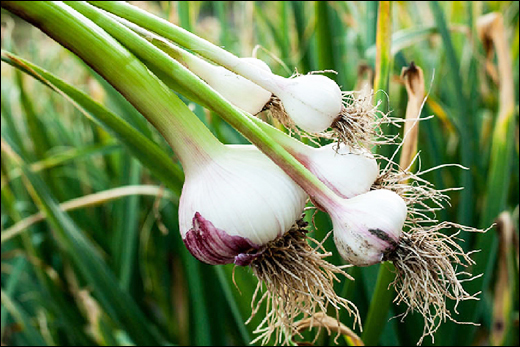Garlic (Allium sativum): Health Benefits, Ayurvedic Uses, Dosage And Side Effects
Abstract
This is one of the oldest plants and possesses many purposes in food and healing, as well as antioxidant, anticarcinogenic, immunostimulatory, and anti aging properties. This is mostly used as spice in the form of bulbs, which are picked straight from the field or after storage. This perennial plant is rich in aroma, pungent taste, and sticky texture and is used as a flavoring agent in food and for medicinal purposes. Its benefits have been widely recognized for many years worldwide, which has helped in promoting better health. So,in every city or state, it is known by different names, such as stinking nose, nectar of the gods, allium, ajo, and clove garlic. In homes, garlic is preserved in the form of pickles; this tastes good and is healthy for the gut and immunity. Garlic is rich in sulphur. And its main bioactive and phytochemical contents made its properties powerful.

Introduction
A plant species in the onion family Alliaceae known as garlic in English or Allium sativum in Latin; also known as lehsun in Hindi. It is indigenous to Central Asia. As of 2023, China has the largest garlic market. Madhya Pradesh is famous for garlic in India. Also, India imports most of the fresh garlic from Afghanistan, the UK, and China. It is specifically an herb that grows into strongly aromatic, round shapes composed of around 12–19 cloves. These cloves are wrapped in membranous skin. Many people consume dehydrated garlic. And in many regions, its fresh green leaves are used as salad during the winter or early spring and are an important source of vitamins and minerals.
Morphological Feature
This is a perennial flowering plant that grows from a bulb. Allium sativum species grow about 2 feet tall. It comprises a tall , erect flowering stem. The leaf is flat, linear, and solid and has an acute apex. The long, juicy green leaves are present and are edible. The flowering is done from July to September in the north. And its cultivation takes 3–4 months.
Bioactive Constituents
The crushing or processing of garlic bulbs releases a compound named Allin, which further interacts with the enzyme alliinase and is converted into allicin (diallyl thiosulfinate). This allicin is responsible for the odour of garlic. This allicin compound is an unstable or self-reacting constituent and changes to different chemicals quickly. If alliciin is absent in aged garlic extract, it can even show a significant biological effect.
Fresh garlic contains organosulfur compounds, phenols, saponins, and polysaccharides.
The main organosulfur and saponin compounds present in garlic are shown below in the table:
| Organosulfur Compounds | Allicin (diallyl thiosulfonate), Alliin (S-allyl cysteine sulfoxide), DAS (diallyl sulfide), DADS & DATS (diallyl disulfides & trisulfides), Ajoene S-allyl-cysteine (SAC) |
| Saponin Compound | Beta – sitosterol, campesterol and stigmasterol (found in berries) |
| Fatty Acids | beta-resorcyclicacid, pyrogallol, gallic acid, rutin, protocatechuic acid, desgalactotigonin-rhamnose, desgalactotigonin-rhamnose and quercitine. |
Benefits Of Garlic
As an immunostimulant agent, its pharmacological properties show a beneficial role in the cardiovascular system (such as lipid profiles, blood pressure reduction, and platelet inhibition).
Garlic is the only herb that can be used more than twice as a natural supplement. It is essential for keeping cholesterol and blood pressure under control, preventing heart disease, improving blood circulation, and preventing cancer. It is commonly used to treat fungus infections. Also aids in the thickening of arteries (atherosclerosis).
1. Role In Cardiovascular System
There are numerous diseases that are related to the heart. Epidemiological studies have identified these disorders as elevated levels of lipids in our bodies (cholesterol and triglycerides), increased coagulation factors, platelet activation, and changes in glucose metabolism.
Garlic contains bioactive constituents such as gamma-glutamyl cysteine. This helps to lower blood pressure.
Garlic juice has been shown to help with heart rate control. Additionally, the mixture of garlic and lemon juice may aid in cholesterol control. Garlic tea also improves blood circulation, keeps plaque from clogging arteries, and prevents atherosclerosis, all of which help to reduce the risk of heart disease.
Garlic extracts, whether aged or dried, help to reduce plaque formation in coronary artery patients. Furthermore, the compound allicin can increase blood flow in tissues while decreasing blood pressure by relaxing the blood vessels.
2. Modulating Immune System
Garlic’s polysaccharides act as immunomodulators, regulating the expression of all immune cells. Fresh, juicy garlic exhibits significant activity in immunomodulation. And it is known for being the best antioxidant ; this includes selenium, vitamin C, and a phytochemical compound called quercetin (which helps in anti-inflammation). This may help in restricting the antigens or other foreign particles (dust, smoke, or pollution) and regaining the antibodies, which help in maintaining and regulating a good immune response and protecting against diseases.
3. Cancer-Fighting Potential
Cancer is increasingly becoming a lifestyle disease. It cannot be treated properly, but it can be avoided. Natural herbs and drugs can help manage the number of blood cells,or lymphocytes. Several studies on the chemopreventive activity of garlic have been conducted using different garlic extracts, which can be fresh, dried, or aged. Recently, it was reported that dried garlic has radical-scavenging activity. The two major compounds found in aged garlic are S-allylcysteinene and S-allylmercapto-L cysteine. In addition, various organosulfur compounds have demonstrated oncogene activity, and these chemicals have been used to induce and transplant tumors in a variety of animal models. This is how garlic helps fight and prevent cancer cells.
4. Antiviral Properties
A recent study has proven that high organosulfur compounds are present in garlic essential oil, which is used to cure a variety of diseases, wounds , infections of the lungs, and STDs as well. Also, the protein present in garlic prevents the Corona virus. The major respiratory tract infection is the Corona virus (SARS-CoV). In this infection, the garlic extract affects the replication of the influenza A virus during the early stages of infection. Individuals with a mild COVID infection were given garlic essential oil, and they got treatment very shortly.
5. Anti-Diabetic Properties
One of the fatal metabolic disorders known as diabetes mellitus occurs when there is an elevation in blood sugar levels, which is mainly due to the body either not producing insulin or producing less insulin. The researchers have found that garlic’s bioactive compound, mainly organosulfur, helps lower hyperglycemia by enhancing the antioxidant capacity of circulatory symptoms. The regulation of type 2 diabetes is controlled by garlic, which is a donor to hydrogen sulfide.
Consumption of 300 grams of garlic twice a day for some weeks can help improve cholesterol, maintain blood pressure, and decrease serum lipid levels.
Use Of Garlic Oil
- Every part of garlic is useful. Whether it is raw or dried,. The raw garlic oil is prepared by the distillation (steam) process. The garlic oil contains volatile sulfur compounds such as DADS and DATS, as discussed above. This consists of 60% of the oil.
- Raw garlic oil contains an important phytochemical called allicin.
- This oil aids in the inhibition of bacteria present in the stomach, such as Helicobacter pylori, which is the infection evaluated by the tests.
- Whereas garlic extract is the best source of antioxidants. This can help us fight against pathogenic microorganisms such as E. coli and Pseudomonas aeruginosa.
- The garlic outer skin is composed of phenolic compounds (such as luteolin and apigenin), which help in bacterial growth inhibition.
Conclusion
An aromatic herbaceous plant that is used as a special ingredient in flavouring foods and some ready to eat snacks. This enhances the flavour of the product and also improves its functionality and shelf life. As discussed above, garlic is composed of organosulfur compounds, some phenolics, and flavonoids. Polysaccharides present in garlic can also play a role in metabolic functions. The onion family is called a blood purifier in Ayurveda. Also in the remedy for coronavirus, garlic helps with the common cold, cough, and other respiratory tract infections. Garlic also contributes to lipid profiles, blood pressure, and platelet function. The preservation of garlic is done in the form of pickles. The fresh leaves of garlic are also helpful to some extent.



